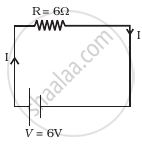Advertisements
Advertisements
Question
Estimate the average drift speed of conduction electrons in a copper wire of cross-sectional area 2·5 × 10−7 m2 carrying a current of 2·7 A. Assume the density of conduction electrons to be 9 × 1028 m−3
Solution
We know that drift velocity,
`V_d=I/(nAq)`
where I is the current, n is charge density, q is charge of electron and A is cross-section area.
`V_d=2.7/(9xx10^28xx2.5xx10^(-7)xx1.6xx10^(-19)`
`V_d=7.5xx10^(-4) `
This is the required average drift velocity.
APPEARS IN
RELATED QUESTIONS
Write its (‘mobility’ of charge carriers) S.I. unit
Estimate the average drift speed of conduction electrons in a copper wire of cross-sectional area 1.0 × 10−7 m2 carrying a current of 1.5 A. Assume the density of conduction electrons to be 9 × 1028 m−3
When electrons drift in a metal from lower to higher potential, does it mean that all the free electrons of the metal are moving in the same direction?
When a current is established in a wire, the free electrons drift in the direction opposite to the current. Does the number of free electrons in the wire continuously decrease?
A current of 1.0 A exists in a copper wire of cross-section 1.0 mm2. Assuming one free electron per atom, calculate the drift speed of the free electrons in the wire. The density of copper is 9000 kg m–3.
Obtain the expression for the current flowing through a conductor having number density of the electron n, area of cross-section A in terms of the drift velocity vd .
The position-time relation of a particle moving along the x-axis is given by x = a - bt + ct2 where a, band c are positive numbers. The velocity-time graph of the particle is ______.
Metals are good conductor of heat than insulator because
An electric bulb.is rated 220 v and 100 watt power consumed by it when operated on 'no volt is:-
- Consider circuit in figure. How much energy is absorbed by electrons from the initial state of no current (ignore thermal motion) to the state of drift velocity?
- Electrons give up energy at the rate of RI2 per second to the thermal energy. What time scale would one associate with energy in problem (a)? n = no of electron/volume = 1029/m3, length of circuit = 10 cm, cross-section = A = (1mm)2

